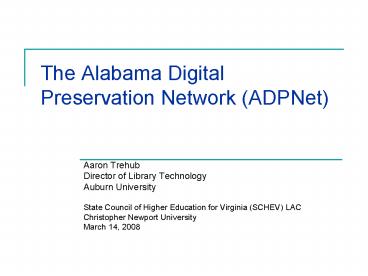The Alabama Digital Preservation Network ADPNet - PowerPoint PPT Presentation
1 / 14
Title:
The Alabama Digital Preservation Network ADPNet
Description:
... of rich digital collections (e.g. AlabamaMosaic)... Modest ... ADPNet currently contains 11 collections ('archival units') from five of seven institutions ... – PowerPoint PPT presentation
Number of Views:44
Avg rating:3.0/5.0
Title: The Alabama Digital Preservation Network ADPNet
1
The Alabama Digital Preservation Network (ADPNet)
- Aaron Trehub
- Director of Library Technology
- Auburn University
- State Council of Higher Education for Virginia
(SCHEV) LAC - Christopher Newport University
- March 14, 2008
2
Background
- ADPNet inspired by experience with NDIIPP
MetaArchive Project - IMLS grant September 2006 through September 2008
- Grant awarded to and administered by Alabama
Commission on Higher Education/Network of Alabama
Academic Libraries (NAAL) in Montgomery - Project director at Auburn University Libraries
- Commitments from seven institutions across the
state
3
The objective
- To create a low-cost, low-maintenance,
sustainable, geographically distributed digital
preservation network for libraries, archives,
museums, and other cultural heritage
organizations in Alabama.
4
The seven participating institutions
- Alabama Department of Archives and History
(Montgomery) - Auburn University (Auburn)
- Spring Hill College (Mobile)
- Troy University (Troy)
- University of Alabama (Tuscaloosa)
- University of Alabama at Birmingham
- University of North Alabama (Florence)
5
The network
- ADPNet is a Private LOCKSS Network (PLN)
- Uses off-the-shelf equipment and a standard
LOCKSS installation - LOCKSS servers (nodes) at all seven participating
institutions - Each institution maintains its LOCKSS server
- Each institution contributes content for
harvesting and archiving by the network - Runs on sweat equity, with help from LOCKSS staff
6
Why Alabama?
- Hurricanes
- Tornadoes
- Growing number of rich digital collections (e.g.
AlabamaMosaic) - Modest financial resources
- Uneven technical support
- Ideal test case for geographically distributed
digital preservation network
7
Why LOCKSS?
- Familiar with it (through MetaArchive Project)
- Simple
- Robust
- Low maintenance
- Cheap (except for membership in the LOCKSS
Alliance) - Good technical support
- Know it works
8
Costs
- Servers LOCKSS server and Web server (for making
content available to the network) - Staff time (less than we anticipated)
- Communication (weekly conference calls, project
listserv, project Wiki) - Some travel (mostly in-state)
- The biggie LOCKSS Alliance membership fee
(annual). Supports LOCKSS software development
and technical support.
9
ADPNet content
- ADPNet currently contains 11 collections
(archival units) from five of seven
institutions - Over 100 gigabytes harvested
- Network capacity one terabyte
- Plenty of room for more collections
- More collections on the way, including audio and
video files
10
ADPNet administration
- ADPNet is a single-state network
- Folded into existing administrative
infrastructure ACHE/NAAL - Not a service organization
- No membership fees (but LOCKSS Alliance
membership mandatory) - In-kind contribution bring up and run a LOCKSS
node in the network - Governance document in the works
11
ADPNet digital preservation awareness survey
- Sent to academic and public libraries, archives,
schools, and state and municipal agencies in
Alabama in February 2008 - 79 responses public libraries largest single
group of respondents - Most important factors in deciding whether to
join digital preservation network reliability,
expertise and support, cost, staffing, and
preservation of mission-critical collections - Most people learn about new initiatives from
conferences and colleagues, so focus on those
12
Lessons learned
- Keep it simple
- Keep it cheap
- Dont get fancy
- Low maintenance
- Low administrative overhead
- Take advantage of existing structures and
relationships (easier to do with single-state
network)
13
Future plans
- Add more content to the network
- Test disaster recovery procedures
- Recruit more member institutions, including
public libraries (e.g. Birmingham Public Library)
and museums - Spread the word
14
Contact
- Aaron Trehub
- Auburn University Libraries
- trehuaj_at_auburn.edu
- http//adpn.org/































